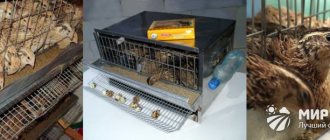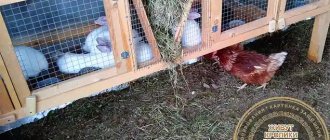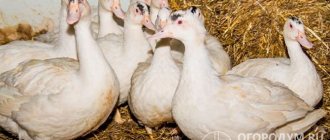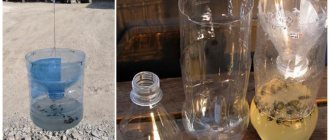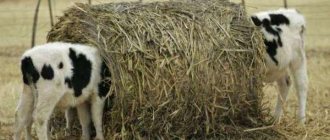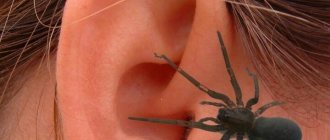Goat wintering shed
The main condition is a dry barn without any drafts. Heating in the barn will only be needed when raising newborn goats. Adult goats independently regulate their body temperature, so they can easily withstand frost in unheated rooms.
In winter, they are kept in stalls, and it is important for the owner to take care of the living conditions and stock up on adequate food.
Even when building a goat house, it is necessary to take into account several points:
- locate it away from garbage dumps and manure pits;
- the presence of windows is mandatory; natural light must enter the barn in large quantities;
- The room must be dry, animals cannot tolerate humidity. And if there are also drafts, they easily get pneumonia - pneumonia.
That is why wood is used for construction; it retains heat better when concrete or brick retains more moisture and dampness.
Winter conditions
The optimal temperature in the barn is +7°C when keeping adults and +10°C when there is a goat with kids in the stall. At lower temperatures, goats need to be insulated with clothing. To do this, they put on old jackets and coats over their front legs and button them at the back. The emphasis is on protecting the animal's chest to prevent the development of colds.
Each animal needs a separate compartment. Goats are freedom-loving animals, so they need to be given a spacious place. Depending on the individual, different stall areas are required per animal:
- kid from 6 months to 1 year - 1.2 sq. m;
- barn goat and breeding male - 2 sq. m;
- female with cubs - 3.5 square meters. m.
There are two types of feeders. Rough feed (hay and straw) is placed in the nursery, concentrates and vegetables are placed in special individual feeders. Install them at a height of 40-50 cm from the floor.
Preparing the barn for winter
To ensure that the wintering of goats goes without problems, goat's rue is prepared, guided by the following recommendations:
- It is better if the goat house has several small windows on the south side than one large one. They are made at a height of more than 1.5 m, otherwise jumping pets may inadvertently knock them out with their hooves. For the winter they are insulated, all cracks are sealed.
- Ventilation is also an important part of the shed; it is through it that air circulates and excess moisture escapes. It is especially relevant during the cold period, since manure in stalls is removed less frequently to save heat. The best option is to equip the room with two ventilation systems. One is located in the form of a tetrahedral pipe under the roof of the goat house, through which stale air is removed. A second pipe or several holes are made below the floor at the beginning of the walls, thanks to which fresh and clean air constantly enters the room and circulates it.
- To save heat, dampers are installed in winter. Some farmers install special filters that heat the incoming air.
- The walls are whitewashed with lime mortar, the whitewashing is renewed 2 times a year. They are insulated using the old-fashioned method - sawdust or wood, or a more modern method is used - an additional artificial wall is placed.
- Along the insulated walls, beds for animals (sleeping places) are attached - 70-80 cm long and 50-60 cm wide. With their help, several problems are solved: goats have a luxurious place to rest, wool gets less dirty in manure and bedding, and the risk of catching a cold is reduced. . The sunbeds also need to be whitewashed.
- It is recommended to use a plank floor; it is easier to clean from manure. However, this does not mean that concrete, clay or dirt floors do not have their place. The floor is raised by 20-25 cm and made at a slope (2 cm per 1 m of room) so that the liquid drains immediately. To remove it from the shed, it is recommended to dig grooves through which the waste will immediately go into cesspools.
- The floor is covered with a thick layer of bedding made from natural materials - peat, sawdust, hay, dry leaves, straw, moss. If the barn does not have beds, then the animals have to sleep on the floor, so you need to approach the floor covering responsibly.
- A well-lit canopy is made in front of the entrance to the goat house. They do not allow the room to cool down.
Winter maintenance without heating system
As mentioned above, there is no need to build a room with a special heating system for most breeds of goats. Due to their anatomical features, animals independently regulate their body temperature, due to which the body adapts to environmental conditions. The characteristics of down and wool breeds were discussed earlier.
Goat - producer
When keeping goats in barns without a heating system, you should still remember to create the most comfortable conditions for the animals. If the contents are free, it is recommended to install wooden flooring in one of the corners of the room. Such coverings raised above the ground allow ungulates to rest comfortably. Stall conditions require the presence of a sufficient layer of warm bedding on the floor.
As for the housing standards for area per animal, they are as follows:
- breeding goat – 2 m²;
- barn goat – 2 m²;
- goat with kids – 3.5 m²;
- young animals aged 6-12 months – 1.2 m².
Winter walks
Goats are active animals and even in winter they need to walk. So that animals can go out into the fresh air for a walk in good weather, a small courtyard is built next to the barn. When the temperature is no more than -10°C and there is no wind, this is where they are fed. The yard is built at the rate of 5 square meters. m per individual.
The breeder shares in the video below what a yard for walking goats should look like in winter:
Daily walks and physical activity help improve the overall tone of animals.
Place to stay overnight
Goats are very clean animals and prefer to sleep not on bare ground, but on a bedding or on a wooden pedestal specially prepared for this. You can make a platform along one of the walls of the barn. The elevation above the floor is about 40 cm high and 50-60 cm wide. Goats simply love to sleep on such elevations. In addition, things will always be warmer on the platform.
In winter, it is especially important to pay attention to the cleanliness of the goat house and disinfect the pallets and bedding on which the animals sleep once a week.
Goat nutrition in winter
The winter diet of goats undergoes significant changes. Adhere to the following rules:
- They increase the proportion of roughage and grain feeds and reduce the amount of light feed (they are used as fertilizing).
- The number of feedings varies from 2 to 4 times a day.
- Since goats are ruminants, the main food is hay and straw. They should always be in the manger so that the animal can refresh itself at any time.
- The diet is structured so that most of it comes from hay, twigs and straw. Meadow or forest hay made from young plants is considered the most useful. Be sure to provide juicy vegetables, fresh and boiled, and fruits - preference is given to apples and pears.
- Vegetables are also added to compound feed, the latter can be partially replaced with cake or bran. A dairy goat requires up to 1 kg of such feed.
- Or they give grains of cereals and legumes. They must first be processed in any way for better digestibility: crushing, sprouting, yeasting, frying. Experts do not recommend feeding whole grains to animals, as they negatively affect the digestion process.
- It is contraindicated to feed goats large amounts of concentrated feed - compound feed, grain, food waste, as they can provoke the development of urolithiasis. When purchasing compound feed, the choice is made on those feeds that are intended specifically for goats. Their composition is balanced and takes into account all the needs of their body. It is usually enriched with ammonium chloride.
- To prevent the occurrence of urolithiasis or urolithiasis, follow the feeding and maintenance regimen of goats. If the disease begins to develop, then concentrates enriched with phosphorus are either reduced or completely removed from the menu. They increase the proportion of green feed, introduce microelements - cobalt, zinc, manganese and copper, and provide a sufficient amount of water.
- Among succulent feeds, the emphasis is on potato tubers, cabbage leaves and root vegetables, in particular, fodder beets. Potato tubers are boiled and given up to 2 kg per day. The remaining vegetables are pre-chopped and fed raw up to 2-5 kg.
- Sources of vitamins are tops and cabbage leaves. However, when feeding beet tops, additional chalk is added. For 1 kg of greens take 1 g of crushed chalk. It neutralizes well the various acids contained in their leaves.
It is better to mix all feeds with hay; it helps vitamins and other nutrients to be more fully absorbed.
Brooms are prepared from tree branches:
- aspen;
- rowan;
- maple;
- ate;
- willows;
- acacia;
- birch;
- raspberries;
- and you;
- nettles
It is enough to prepare 80 brooms for one individual. Birch twigs are fed in limited quantities; they must be alternated with other species. If for some reason they did not have time to harvest, then they are replaced with leafless branches of deciduous trees. They contain many useful substances that animals need.
Some farmers play it safe and add vitamin complexes directly to the food of high-yielding, pregnant (pregnant), sick and weakened goats.
How much and what kind of feed is required per adult for the winter:
- hay, straw, twigs - 500 kg;
- concentrates - 200 kg;
- vegetables - 200 kg;
- mineral supplements - meat and bone meal, milk powder, chalk - 5 kg;
- salt - 3-4 kg.
If we talk about drinking, it is better to install heated drinking bowls. Goats are quite “hot” animals; their normal body temperature is considered to be 40°C, so they drink hot water. There should be free access to water, especially for males, since they are predisposed to urolithiasis.
You can find more information about goat nutrition at different times of the year here.
Ways to increase milk yield in winter: lactation
It is equally important to follow a special diet during lactation. The quality of milk, milk productivity and the health of the animal primarily depend on the goat’s nutrition.
To increase milk yield, add more minerals, branches and leaves, vegetables, grains, root vegetables, high-quality hay, and water to the diet. Milk yield also depends on milking. Try to do this periodically, at the same time, and milk out the milk to the last drop.
Take walks and remember that any stress can negatively affect the milk production process!
What can goats get sick with during the cold season?
In winter, goats are susceptible to developing the following diseases:
- Helminthiasis. There are worms in a goat's body all year round, but in winter their presence has a negative impact on the overall well-being - it weakens, the immune system malfunctions, and food is poorly absorbed. Before the winter period, all animals must be treated for helminths.
- Frostbite. Goats that go for walks in winter are not immune to frostbite in the most sensitive parts of the body, for example, the udder or ears in long-eared breeds. To reduce the risk of frostbite, the most susceptible parts are well lubricated with Vaseline, fatty cream or special ointment. Goats are not allowed out of the barn if the thermometer drops below 10°C below zero.
- Hoof injuries. Animals love to frolic, and nothing can stop them - neither snow nor ice. After each walk, check the condition of the hooves, as they can become clogged with snow or injured by sharp edges of ice. The yard area is promptly cleared of snow and ice.
Separately, information on goat diseases can be found here.
In winter, caring for goats comes down to proper feeding and creating comfortable conditions in the barn. The main thing is the absence of drafts and dampness. In this case, the animal will survive the winter well, and this will not negatively affect milk yield in the future.
0
0
Copy link
Always hot water
It's amazing how hot water goats can drink! Sometimes the breeder may even think that the goat will burn its tongue, but it should be remembered that the body temperature of these animals is higher than that of humans (39-40 degrees). If you have the opportunity to install heated drinking bowls for goats, the animals will certainly appreciate it. It is especially important that goats always have access to water, since due to their anatomical features they are prone to urolithiasis and must drink a lot.
Feeding mated goats
At home, the diet of pregnant and single females differs. Gestation of kids lasts about 150 days. At this time, the goat’s body needs twice as much food containing calcium, protein and vitamins. The total nutritional value of the given feed should also be 35 - 45% higher.
During pregnancy, the feeding regimen also changes: animals are given food 6-7 times a day.
Particular attention is paid to quality: mold, rot, and fungal deposits are not allowed on the feed. All vegetables and root vegetables are thoroughly washed and cut into small pieces.
As the second trimester of pregnancy begins, goats are given more protein feed. A good source of protein is bean hay, which is fed in equal proportions with cereals. It is also recommended to add fishmeal, cake and dry feed yeast to food.
A balanced diet for pregnant goats also includes table salt licks or a mineral mixture: coarse salt with the addition of cobalt, zinc, iodine, copper, iron and manganese, magnesium. The lack of calcium is compensated for with a mixture of salt, bone meal and chalk. Additionally, animals should be supplemented with vitamins a, e, d.
Approximate daily menu for a female goat:
- 2.5 kg of hay,
- 3 kg of succulent food,
- 500 g of concentrates,
- 500 grams of straw,
- 500 grams of boiled potatoes,
- up to 1 kg of branch feed.
Goat's rue on deep litter
Like any animal, goats need a warm place in winter. Ventilation is good, drafts are bad.
Cold air on the floor of the goat house can accumulate toxic gases, but with proper ventilation, cold, unhealthy air will be forced out, and warm, clean air from the ceiling will flow down. However, keep in mind that improper ventilation, when there is a constant draft, makes goats vulnerable to pneumonia.
Seal the windiest sides of the shed with plywood, and if possible, add that cheap sheathing around the perimeter.
Probably everyone knows about the deep litter method when keeping chickens. Some people also use it for goats when the harshest cold sets in. At this time, clean straw is laid on top of the old, which in turn composts and generates heat. With this method, proper ventilation is very important! In the spring, the entire barn is cleaned out and the finished compost is sold.
For sleeping and resting in winter, goats are provided with wooden platforms, avoiding contact with cold ground or mud in any way.
Prevention of frostbite
Goats that are outside in winter can get frostbite on particularly sensitive areas of the body. As a rule, the udder is at risk. To protect it, before letting the animals go for their daily walk, smear the udder of dairy goats with a special anti-frostbite ointment or Vaseline. For breeds with long ears, such as the Nubian goat, it would be useful to treat the inner surface of the ear with ointment, since even it can be caught in severe frost.
Find out how to choose the right dairy goat here
©
